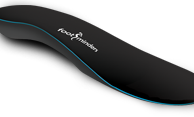The Truth about Custom Orthotics
the bottom line: very few people need them!
Below is an article published in the Journal of the American Orthopaedic Foot and Ankle Society (AOFAS). It speaks volumes about the efficacy of standard orthotics (such as Footminders) as compared to those expensive custom-made orthotics products that are eagerly recommended by some podiatrists and specialty foot care stores.
|
Inexpensive Off-The-Shelf Shoe Inserts More Effective Than Custom-Made Ones SEATTLE, Oct. 15, 1996 — The American Orthopaedic Foot and Ankle Society (AOFAS) announced today the results of a two-year prospective randomized national study on the treatment of heel pain. The study found inexpensive off-the-shelf shoe inserts to be more effective than plastic custom arch supports in the initial treatment of heel pain (plantar fasciitis). Potentially, this finding could save more than $200 million in health care costs annually. Heel pain affects over two million Americans annually and is the most common foot problem seen in medical practice. Nonoperative care for heel pain provides satisfactory treatment for 90 percent of patients. However, research has not established which initial nonoperative care is best. The current study, involving 15 orthopaedic foot and ankle centers, was designed to answer this question. The investigation, conducted by the AOFAS Heel Pain Study Group, looked at the effectiveness of stretching exercises and orthotic devices in the treatment of heel pain. The researchers examined 236 patients who had no previous treatment for their heel pain and no serious medical problems. The study did not include chronic heel pain sufferers who had received other treatments for their condition. The patients were divided (randomized prospectively) among five treatment groups. One group did only Achilles tendon and plantar fascia stretching exercises. (The plantar fascia is the band of tissue that stretches from the ball of the foot to the heel.) The other four groups used either an off-the-shelf shoe insert or custom arch support along with the stretching exercises. The devices studied included the Bauerfeind Viscoheel, Hapad Comforthotic, Tuli Heel Cup and a custom made polypropylene arch support. All of the patients were examined by an orthopaedic foot and ankle specialist and asked to fill out an activity and symptom questionnaire. They returned after eight weeks of treatment for a repeat examination and questionnaire. Seventy-two percent of those who did only Achilles tendon and plantar fascia stretching improved. Ninety-five percent of those who used the Bauerfeind Viscoheel (silicon heel cushion), 88 percent of those who used the Tuli heel cup (rubber heel cushion) and 81 percent of those who used the Hapad Comforthotic (felt heel cushion/arch support) improved. Sixty eight percent of the patients who wore a custom-made plastic arch support improved. Interestingly, patients who stood on their feet for a full work day showed significantly less improvement with a custom arch support than those who used an off-the-shelf insert: 44 percent showed improvement with a custom arch support versus 96 percent who showed improvement with an off-the-shelf insert. “The study clearly demonstrates that a stretching program plus an inexpensive off-the-shelf shoe insert is the best and most cost effective treatment for the first onset of heel pain,” said Glenn Pfeffer, M.D., San Francisco, Chairman of the AOFAS Heel Pain Study Group. “These findings will allow patients and the health care system to save hundreds of millions of dollars each year by avoiding the unnecessary prescription of a rigid custom arch support for the initial treatment of heel pain.” Dr. Pfeffer noted that even without a doctor’s visit, almost three quarters of individuals can find significant relief from heel pain by performing a home exercise program that includes Achilles tendon and plantar fascia stretching. “Adding an inexpensive off-the-shelf shoe insert to the stretching program leads to an even better result,” Dr. Pfeffer said. He emphasized that rigid custom arch supports have a clear role in the treatment of many foot conditions, but the results of this study indicate that they have no role in the initial treatment of heel pain.
|



 100% Secure
100% Secure






